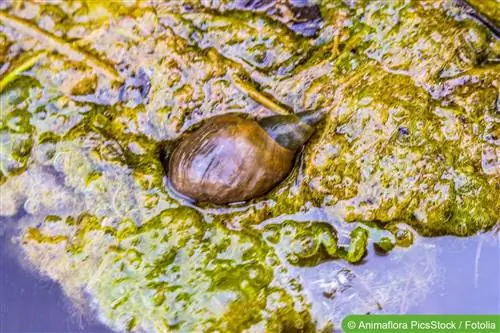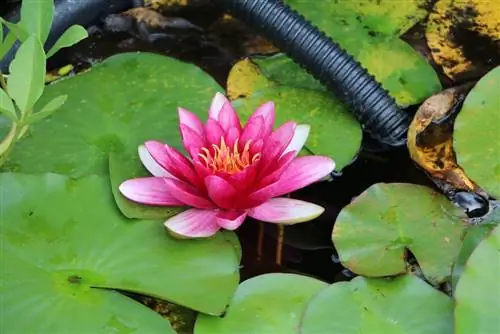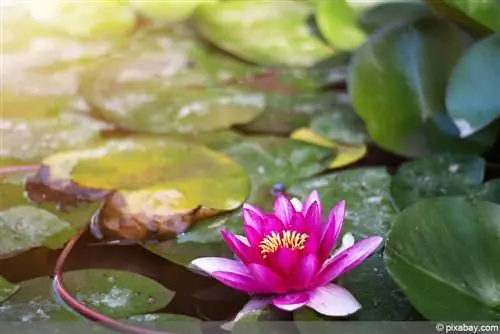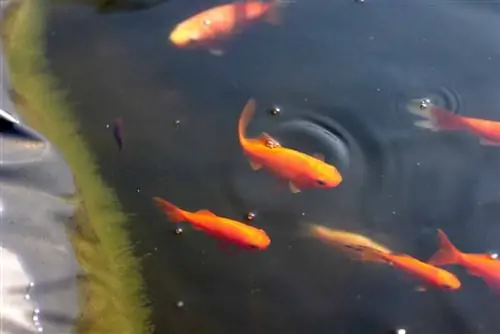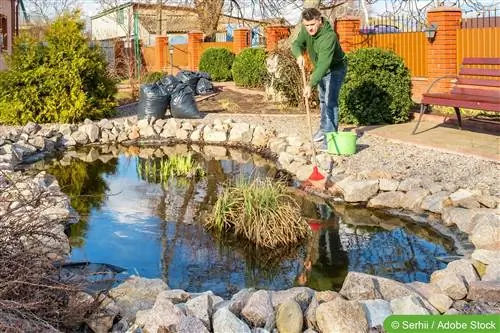- Author admin [email protected].
- Public 2023-12-17 03:39.
- Last modified 2025-01-24 12:45.
It is not uncommon for pond owners to initially make big mistakes when keeping pond snails. The animals' demands are underestimated, although if you follow a few basics it could be very easy to keep snails in your own pond.
Because snails in your own pond can prove to be useful! Some feed on algae and help keep the water clean.
Which snails are suitable for your own pond?
When selecting animals, preference should always be given to species that are already native to our environment. More exotic animals would quickly flee. Normal garden ponds literally do not offer such animals a comfortable climate. In the worst case, fatal consequences could arise for surrounding biosystems. Caution is advised with water snails because they can be intermediate hosts for trematodes, especially if they were collected in the wild, which is actually illegal. Water snails should only be used in small ponds. The small flukes could cause considerable damage, especially in ponds that were created for koi carp or fish farming. However, they do not pose a problem in small ponds, even if there are no small fish in them. To be on the safe side, the water snails could initially be observed in a holding tank with young fish.
The most ideal species are pointed mud snails, ramshorn snails and swamp snails. However, these cannot simply be placed in the pond without further ado. The demands on water conditions and the environment can be very individual for each species of snail. That's why you should definitely take a look at the individual needs of the animals in order to find the best compromise for the snails and the rest of the pond inhabitants. To ensure that parts of the population do not die immediately, the animals should first be accustomed to the climate of the pond.
A pond suitable for snails should have the following features:
- It is at least 80 cm deep
- Provided with a muddy bottom
- 7 is a good pH value
- Temperatures above 25 °C should be avoided
- The oxygen content of the water should be appropriately high
- No other animals should target the new residents as a source of food
How to keep the snails properly
The pointed mud snail is not only found in hobby gardeners' ponds, but also in natural waters, especially in rivers. This species is the easiest to keep. It is one of the lung breathers, so it is not so tied to water quality and oxygen content. She likes to be seen just below the surface of the water from which she can even see. Due to their size of about 7 cm, adult sharp mud snails are not endangered by other fish. Their main food source is algae, so it can help keep the water clean. It prevents extremes such as drying out or freezing of the pond, but if temperatures rise above 26 °C for a long time, this usually results in mass extinctions. You should never lose sight of the snail population. A single black mud snail can lay hundreds of eggs, often near plants. Sometimes this forces proud pond owners to release snails into the wild in order to limit the number of offspring.
The ramshorn snail is already known in northern Germany and on the Upper Rhine and is often found in nature. They are occasionally found in ponds, canals, ditches and of course ponds. In the literature it is sometimes also called a plate snail. It will not eat he althy plants unless another food source is available. Ramshorn snails prefer to eat algae or dead plants. In order to prevent mass extinctions in this species, the water temperature and pH value should be checked at regular intervals. If the pH value falls below 5, this usually means that the entire population of ramshorn snails will die. Here too, temperatures above 26 °C must be avoided! In contrast to the pointed mud snail, ramshorn snails reproduce rather slowly. A sudden mass population is not expected. In winter, the snails burrow into the mud at the bottom of the pond and draw on their reserves. A long, hard winter can also lead to the snails becoming extinct.
The last snail in our recommendations is the marsh snail. It can completely close its 5 cm large, right-handed housing with a “lid” that has grown onto it. This also helps them survive harsher and longer winters, buried deep in the pond bottom. Marsh snails also reproduce only slowly. In contrast to many other snail species, marsh snails have separate sexes and give birth to their offspring live. At least one pair would be necessary for reproduction. These snails feel most comfortable in soft water with a pH value between 7 and 8. The marsh snail contributes a particularly large part to the purification of the water because, in addition to algae, it also eats plankton, dead plant parts, bacteria and detritus (organic matter that decays). If this species of snail runs out of food, they fall into a state of paralysis to survive.
There is no reason not to have snails in the pond
Putting snails in the pond has many advantages. The species presented could even be kept together in a pond if all of the conditions mentioned are observed. Some snails are beautiful to look at. They make an artificially created pond look even more authentic, while also keeping the water clean. However, if the animals' demands are not taken into account, they can die quickly. However, a well-maintained pond is only truly complete with its snails.
What you should know about pond snails in brief
If you already have enough plants in your pond and don't want to plant additional plants (such as duckweed) to provide shade and thus reduce algae, pond snails could help. But be careful: not all species are suitable for the garden pond - some of these animals eat aquatic plants faster than you can see! These include:
- Pointed mud snails - a species of freshwater snail that is widespread in Europe and can still live in heavily polluted waters. It is only suitable to a limited extent for the garden pond, as this type of snail grows very quickly and likes to attack the plants that are available when there is a lack of food. If you decide to keep small mud snails, you should definitely think about adding enough food. The same applies to the small mud snail: it also feels comfortable in heavily polluted waters and eats all aquatic plants bare when there is a lack of food.
- The native ramshorn snail, also known as the plate snail, is more decorative and, above all, more useful. It is popular with connoisseurs because of its decorative red to dark purple color. The hermaphrodites, which mate mutually, lay flat, transparent clumps of eggs on the undersides of leaves, wood or stones. Since the ramshorn snail is a lung breather, meaning it comes to the surface of the water to breathe, it is easy to fish if there is an overpopulation.
- The spring bladder snail is surprisingly fast for a snail. It is mobile and likes to glide along the surface of the water, as it is also a so-called lung breather. Their delicate shell is brown-yellow-black-blue, and both males and females grow up to 11 mm in size. The bladder snail prefers to feed on algae, but the little animals also love to eat carrion, fish food and lettuce.
- The marsh snail is the only aquatic snail that can feed as both a filter feeder and a grazer. Not only does it eat leftover fish food, algae and plant remains, it can also filter plankton out of the water. The marsh snail is a slow and calm animal and grows up to 40 mm in size. After mating, the female snail gives birth to tiny, fully formed baby snails.
- Other important species of pond snails are the pointed horn snail, the apple snail as a focal point and the tower snail, which is of less decorative use due to its hidden lifestyle and rather nocturnal activities, but ensures plenty of loosening of the soil by also eating plant remains, which have already sunk into the gravel, eat with great appetite.

